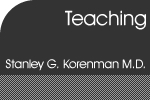

|
<< Previous Section | < Previous Page | Next Page > | Next Section >>
Bibliography (page 9 of 11) Miller, M. (2001). "Phase I cancer trials: a crucible of competing priorities." Int Anesthesiol Clin 39(3): 13-33. This erudite yet clear exposition describes the intrinsic difficulty physicians have in divorcing their clinical responsibilities from the goals of research. Because of their role as healer, the physicians had difficulty conveying the idea that the trial was designed to demonstrate toxicity and no control of tumors is expected. This inability to confront the issue contributes greatly to the therapeutic misconception that is so widespread among the surveys. Millat, B., F. Borie, et al. (2005). "Patient's Preference and Randomization: New Paradigm of Evidence-based Clinical Research." World Journal of Surgery 29(5): 596. Studies of surgical procedures have rarely been randomized, markedly diminishing the validity of a trial through bias. The authors discuss that situation, review a number of professional randomization schemes, and propose one of their own. A number of these patients make an early choice whether they are willing to be randomized and the study is done on those who are. The others would be treated with their preference. To me, this does not seem to be so different from medical therapies. However, they also add another step in which a group of surgeons make an initial determination as to the need for the procedure. The study evaluates both randomized and non-randomized subjects according to patient or doctor preferences. http://www.springerlink.com/openurl.asp?genre=article &id=doi:10.1007/s00268-005-7920-z Nagasako, E. M. and D. A. Kalauokalani (2005). "Ethical aspects of placebo groups in pain trials: Lessons from psychiatry." Neurology 65(12_suppl_4): S59-65. These investigators ask how they may evaluate the appropriateness of the use of placebo arms in pain trials in the face of a wide range of effective therapies. They deal with what can be learned from prior work, quality of the proposed study, the likelihood of harm in the placebo arm, and the degree of harm and whether alternatives to the placebo are consistent with the research objectives and feasible. http://www.neurology.org/cgi/content/abstract/65/12_suppl_4/S59 Kopelman, L. M. and T. F. Murphy (2004). "Ethical Concerns About Federal Approval of Risky Pediatric Studies." Pediatrics 113(6): 1783-1789. This report explores the ethical considerations surrounding pediatric research grants in which children will be exposed to a greater degree of risk than any projected therapeutic benefit or in the performing experiments with greater than a minor degree of risk over "minimal" in healthy individuals. Such studies require the RIB to send the protocol to the department of HHS for approval by the secretary, the so-call "407 approval." This report analyzes the 407 process and finds it wanting or vague in a number of ways. A very good analysis. http://pediatrics.aappublications.org/cgi/content/full/113/6/1783 Wendler, D. (2004). "Risk standards for pediatric research: Rethinking the Grimes ruling." Kennedy Inst Ethics Journal 14(2): 187-98. This think piece was directed at the Grimes (lead paint study in Baltimore) Ruling severely limiting research in children that provided no benefit but yet was associated with a certain amount of risk. This has stimulated much discussion of the risk limitations of pediatric research as well as attempts to assure that meaningful research care be carried out on pediatric patients. Annett, R. D., J. L. Brody, et al. (2004). "Perception of risk associated with asthma research procedures among adolescents, parents, and pediatricians." Journal of Allergy and Clinical Immunology 114(5): 1138. This very nice paper addressed an important subject. By comparing risk levels as perceived by the adolescent subjects as well as parents and pediatricians, a strong perception of their views and a wide range of argument was found. In the perceptions of benefits, I think that they did not distinguish between clinical procedure and procedure for research purposes, especially spirometry. Parents and adolescents thought that placebo was beneficial, leading to concern over the subjects' perception of research. http://www.sciencedirect.com/science/article/B6WH4-4DR7WSG-W /2/f72ed7a1d125d3f53a77648ea2de794b << Previous Section | < Previous Page | Next Page > | Next Section >> |
Chapter 3 Quick Links Ethics and Study Design Introductory Ethics Design Appropriate Risk to Benefit Ratio Selection of Subject Populations Cases Bibliography Chapter 3 Download (PDF) |